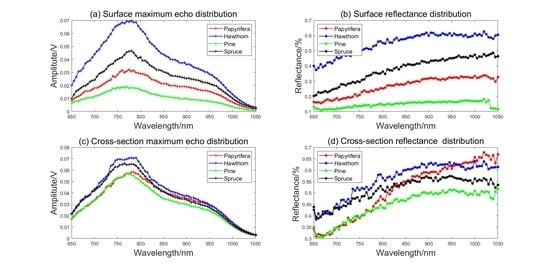Feasibility Study on Hyperspectral LiDAR for Ancient Huizhou-Style Architecture Preservation
Abstract
1. Introduction
- We confirmed the consistency of spectra collected by the AOTF-HSL from both the surface and the cross-section parts of the timber samples.
- We classified wood species and discriminated the building-age of the timber components from ancient architectures based on the AOTF-HSL derived spectral information.
- For the first time, we revealed the possibility of employing the AOTF-HSL measurements to classify the gnawed timber component.
2. Instrument and Measurements
2.1. AOTF-HSL
2.2. Distance Measurements
2.3. Hyperspectral Measurements
3. Samples and Methods
3.1. Samples
3.2. Classification Methods
4. Experiments and Analysis
4.1. Feasibility Test of Surface Spectrum
4.2. Measurement of Aging Trends Based on HSL Reflectance
4.3. Preliminary Analyze Difference between Gnawed and Undamaged Samples
4.4. Classification Performance
- Dataset 1: pine samples including 0-year, 100-year, and 300-year.
- Dataset 2: spruce samples including 0-year, 100-year, and 300-year.
- Dataset 3: pine samples in Dataset 1 and gnawed sample from the 100-year building.
- Dataset 4: pine, spruce, papyrifera, and hawthorn samples taken from the same 100-year building.
- Dataset 5: Dataset 4 and the gnawed sample from the 100-year building.
- Dataset 6: all samples.
5. Conclusions
- The tendencies of the surface and cross-section hyperspectral reflectance profiles are similar. The surface spectra can be used in the classification for the extraction of timber component physical properties.
- Different wood species with the same building-age have different hyperspectral reflectance profiles; it is effective to classify wood species with AOTF-HSL measurements in order to provide a basis for further judging materials of ancient buildings.
- The same wood species with different building-ages have different hyperspectral reflectance profiles; the classification accuracy of building-age reaches 100% by AOTF-HSL measurements, based on several channels, to provide the basis for further judging the original state and the repaired state of an ancient building.
- The gnawed component classified from the undamaged components, based on the hyperspectral reflectance easily, will be a new, non-contact approach to detect the damaged component.
Author Contributions
Funding
Acknowledgments
Conflicts of Interest
References
- D’Ayala, D.; Wang, H. Conservation Practice of Chinese Timber Structures. J. Archit. Conserv. 2006, 12, 7–26. [Google Scholar] [CrossRef]
- The National Congress of China. The Relics Conservation Law of the People’s Republic of China (Revised Edition); The National Congress of China: Beijing, China, 2001. [Google Scholar]
- Luo, Z.W. The Science of Chinese Architectural Heritage Conservation Theory and Practice. In Collection of Papers on Architecture; The Foreign Language Press: Beijing, China, 1999; pp. 344–398. [Google Scholar]
- D’Ayala, D.; Wang, H. Structural Preservation of Chinese Architectural Heritage. J. Archit. Conserv. 2006, 12, 53–70. [Google Scholar] [CrossRef]
- D’Ayala, D.; Forsyth, M. What is conservation engineering? In Structures & Construction in Historic Building Conservation Forsyth; Blackwell Publishing Ltd.: Oxford, MS, USA, 2007; pp. 1–11. [Google Scholar]
- Baptista, M.L.V. Documenting a complex modern heritage building using multi image close range photogrammetry and 3d laser scanned point clouds. In Proceedings of the XXIV International CIPA Symposium, Strasbourg, France, 2–6 September 2013. [Google Scholar]
- Jaafar, H.A.; Meng, X.L.; Sowter, A.; Bryan, P. New approach for monitoring historic and heritage buildings: Using terrestrial laser scanning and generalised Procrustes analysis. Struct. Control Health Monit. 2017, e1987. [Google Scholar] [CrossRef]
- Scherer, M. About the synthesis of different methods in surveying. In Proceedings of the International Symposium of CIPA 2001, Potsdam, Germany, 18–21 September 2001. [Google Scholar]
- Mileto, C.; Vegas, F. Survey and Restoration. In Proceedings of the Conservation of Cultural Heritage in the Digital Era, Florence, Italy, 22–24 May 2017. [Google Scholar]
- Summit, J. Topography as historiography: Petrarch, Chaucer, and the making of medieval Rome. J. Mediev. Early Mod. Stud. 2000, 30, 211–246. [Google Scholar] [CrossRef]
- Majid, Z.; Ariff, M.F.M.; Idris, K.M.; Yusoff, A.R.; Saeman, A.A.B. Three-dimensional mapping of an ancient cave paintings using close-range photogrammetry and terrestrial laser scanning technologies. In Proceedings of the 3D Virtual Reconstruction and Visualization of Complex Architectures, Nafplio, Greece, 1–3 March 2017. [Google Scholar]
- Tangelder, J.W.H.; Ermes, P.; Vosselman, G.; Van Den Heuvel, F.A. CAD-based photogrammetry for reverse engineering of industrial installations. Comput. Aided Civ. Infrastruct. Eng. 2003, 18, 264–274. [Google Scholar] [CrossRef]
- Murphy, M.; McGovern, E.; Pavia, S. Historic building information modelling (HBIM). Struct. Surv. 2009, 27, 311–327. [Google Scholar] [CrossRef]
- Henek, V.; Venkrbec, V. BIM-Based Timber Structures Refurbishment of the Immovable Heritage Listed Buildings. In Proceedings of the IOP Conference Series: Earth and Environmental Science, Prague, Czech, 11–15 September 2017. [Google Scholar]
- Fregonese, L.; Barbieri, G.; Biolzi, L.; Bocciarelli, M.; Frigeri, A.; Taffurelli, L. Surveying and Monitoring for Vulnerability Assessment of an Ancient Building. Sensors 2013, 13, 9747–9773. [Google Scholar] [CrossRef]
- Arias, P.; Caamano, J.; Lorenzo, H.; Armesto, J. 3D Modeling and Section Properties of Ancient Irregular Timber Structures by Means of Digital Photogrammetry. Comput. Aided Civ. Infrastruct. Eng. 2007, 22, 597–611. [Google Scholar] [CrossRef]
- Maldonadoa, G.O.; Newsomeb, S.R.; Maghiara, M.; Clendenena, J.T.; Jackson, N.M. Discrepancy Analysis Between Close-Range Photogrammetry and Terrestrial LiDAR. Mec. Comput. 2016, XXXIV, 245–268. [Google Scholar]
- Kedzierski, M.; Fryskowska, A. Methods of laser scanning point clouds integration in precise 3D building modelling. Measurement 2015, 74, 221–232. [Google Scholar] [CrossRef]
- Yoon, J.S.; Sagong, M.; Lee, J.S.; Lee, K.S. Feature extraction of a concrete tunnel liner from 3D laser scanning data. Ndt E Int. 2009, 42, 97–105. [Google Scholar] [CrossRef]
- Riggio, M.; D’Ayala, D.; Parisi, M.A.; Tardini, C. Assessment of heritage timber structures: Review of standards, guidelines and procedures. J. Cult. Herit. 2018, 31, 220–235. [Google Scholar] [CrossRef]
- Smith, I.; Snow, M.; Asiz, A.; Vasic, S. Failure mechanisms in wood-based materials: A review of discrete, continuum, and hybrid finite-element representations. Holzforschung 2007, 61, 352–359. [Google Scholar] [CrossRef]
- Henriques, D.F.; Nunes, L.; Cruz, H.; Brito, J. Diagnosis of old timber structures. The case of the future Wine Museum of Bucelas. In Proceedings of the International Conference Heritage 2008, Vila Nova de Foz Côa, Portugal, 7–9 May 2008. [Google Scholar]
- Yastikli, N. Documentation of cultural heritage using digital photogrammetry and laser scanning. J. Cult. Herit. 2007, 8, 423–427. [Google Scholar] [CrossRef]
- Fregonese, L.; Taffurelli, L. 3D model for the documentation of Cultural Heritage: The wooden domes of St. Mark’s Basilica in Venice. In Proceedings of the 3D-ARCH 2009: 3D Virtual Reconstruction and Visualization of Complex Architectures, Trento, Italy, 25–28 February 2009. [Google Scholar]
- Kaasalainen, S.; Lindroos, T.; Hyyppa, J. Toward hyperspectral lidar: Measurement of spectral backscatter intensity with a supercontinuum laser source. IEEE Geosci. Remote Sens. Lett. 2007, 4, 211–215. [Google Scholar] [CrossRef]
- Chen, Y.W.; Räikkönen, E.; Kaasalainen, S.; Suomalainen, J.; Hakala, T.; Hyyppä, J.; Chen, R.Z. Two-channel hyperspectral LiDAR with a supercontinuum laser source. Sensors 2010, 10, 7057–7066. [Google Scholar] [CrossRef]
- Kaasalainen, S.; Kukko, A.; Lindroos, T.; Litkey, P.; Kaartinen, H.; Hyyppä, J.; Ahokas, E. Brightness Measurements and Calibration with Airborne and Terrestrial Laser Scanners. IEEE Trans. Geosci. Remote Sens. 2008, 46, 528–534. [Google Scholar] [CrossRef]
- Hakala, T.; Suomalainen, J.; Kaasalainen, S.; Chen, Y.W. Full waveform hyperspectral LiDAR for terrestrial laser scanning. Opt. Express 2012, 20, 7119–7127. [Google Scholar] [CrossRef]
- Chen, Y.W.; Jiang, C.H.; Hyyppä, J.; Qiu, S.; Wang, Z.; Tian, M.; Li, W.; Puttonen, E.; Zhou, H.; Feng, Z.Y.; et al. Feasibility Study of Ore Classification Using Active Hyperspectral LiDAR. IEEE Geosci. Remote Sens. Lett. 2018, 15, 1785–1789. [Google Scholar] [CrossRef]
- Chen, Y.W.; Li, W.; Hyyppä, J.; Wang, N.; Jiang, C.H.; Meng, F.R.; Tang, L.L.; Puttonen, E.; Li, C.R. A 10-nm Spectral Resolution Hyperspectral LiDAR System Based on an Acousto-Optic Tunable Filter. Sensors 2019, 19, 1620. [Google Scholar] [CrossRef]
- Jiang, C.H.; Chen, Y.W.; Wu, H.H.; Li, W.; Zhou, H.; Bo, Y.M.; Shao, H.; Song, S.J.; Puttonen, E.; Hyyppä, J. Study of a High Spectral Resolution Hyperspectral LiDAR in Vegetation Red Edge Parameters Extraction. Remote Sens. 2019, 11, 2007. [Google Scholar] [CrossRef]
- Shao, H.; Chen, Y.W.; Yang, Z.R.; Jiang, C.H.; Li, W.; Wu, H.H.; Wen, Z.J.; Wang, S.W.; Puttonen, E.; Hyyppä, J. A 91-Channel Hyperspectral LiDAR for Coal/Rock Classification. IEEE Geosci. Remote Sens. Lett. 2019, in press. [Google Scholar] [CrossRef]
- Pfennigbauer, M.; Ullrich, A. Multi-wavelength airborne laser scanning. In Proceedings of the International Lidar Mapping Forum (ILMF), New Orleans, LA, USA, 7–9 February 2011. [Google Scholar]
- Fernandez-Diaz, J.; Carter, W.E.; Glennie, C.; Shrestha, R.L.; Pan, Z.G.; Ekhtari, N.; Singhania, A.; Hauser, D.; Sartori, M. Capability assessment and performance metrics for the Titan multispectral mapping LiDAR. Remote Sens. 2016, 8, 936–968. [Google Scholar] [CrossRef]
- Pesci, A.; Teza, G. Terrestrial laser scanner and retro-reflective targets: An experiment for anomalous effects investigation. Int. J. Remote Sens. 2008, 29, 5749–5765. [Google Scholar] [CrossRef]
- Schaepman-Strub, G.; Schaepman, M.; Painter, T.H.; Dangel, S.; Martonchik, J.V. Reflectance quantities in optical remote sensing-definitions and case studies. Remote Sens. Environ. 2006, 103, 27–42. [Google Scholar] [CrossRef]
- Du, L.; Gong, W.; Shi, S.; Yang, J.; Sun, J.; Zhu, B.; Song, S. Estimation of rice leaf nitrogen contents based on hyperspectral LIDAR. Int. J. Appl. Earth Obs. Geoinf. 2016, 44, 136–143. [Google Scholar] [CrossRef]
- Langley, P.; Iba, W.; Thompson, K. An analysis of Bayesian classifiers. In Proceedings of the Tenth National Conference on Artificial Intelligence (AAAI), San Jose, CA, USA, 12–16 July 1992. [Google Scholar]
- Yan, X.; Wu, Q.; Sheng, V.S. A Double Weighted Naive Bayes with Niching Cultural Algorithm for Multi-Label Classification. Int. J. Pattern Recognit. Artif. Intell. 2016, 30, 1650013-1–1650013-23. [Google Scholar] [CrossRef]
- Sinha, H.; Bagga, R.; Raj, G. An analysis of ICON aircraft log through sentiment analysis using SVM and Naive Bayes classification. In Proceedings of the International Conference on Information Technology (InCITe), Noida, India, 10–12 August 2017; pp. 53–58. [Google Scholar]
- Vapnik, V.N. An overview of statistical learning theory. IEEE Trans. Neural Netw. 1999, 10, 988–999. [Google Scholar] [CrossRef]
- Burges, C.J. A Tutorial on Support Vector Machines for Pattern Recognition. Data Min. Knowl. Discov. 1998, 2, 1–43. [Google Scholar] [CrossRef]
- Lorena, A.C.; De Carvalho, A.C. Evolutionary tuning of SVM parameter values in multiclass problems. Neurocomputing 2008, 71, 3326–3334. [Google Scholar] [CrossRef]
- Pedregosa, F.; Varoquaux, G.; Gramfort, A.; Michel, V.; Thirion, B.; Grisel, O.; Blondel, M.; Prettenhofer, P.; Weiss, R.; Dubourg, V.; et al. Scikit-learn: Machine learning in Python. J. Mach. Learn. Res. 2011, 12, 2825–2830. [Google Scholar]
- Heikkinen, V.; Tokola, T.; Parkkinen, J.; Korpela, I.; Jaaskelainen, T. Simulated multispectral imagery for tree species classification using support vector machines. IEEE Trans. Geosci. Remote Sens. 2009, 48, 1355–1364. [Google Scholar] [CrossRef]
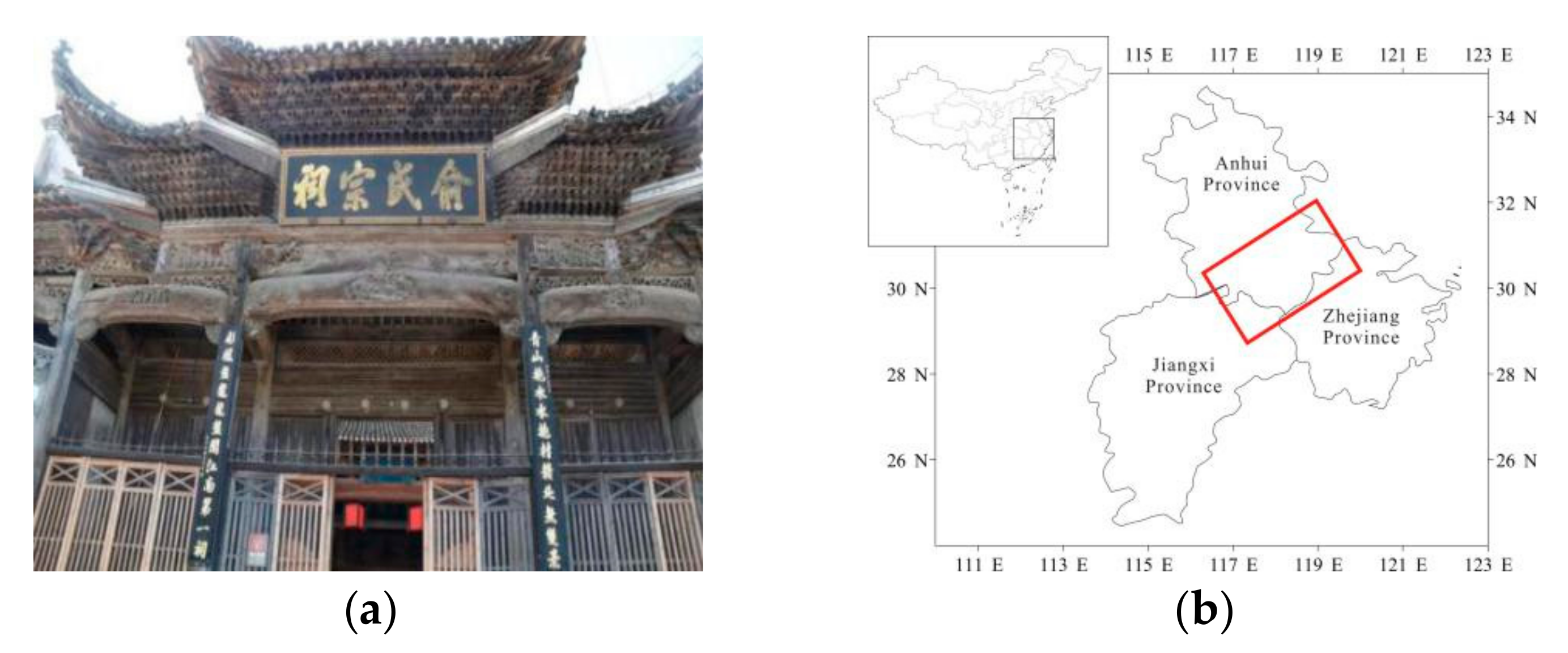
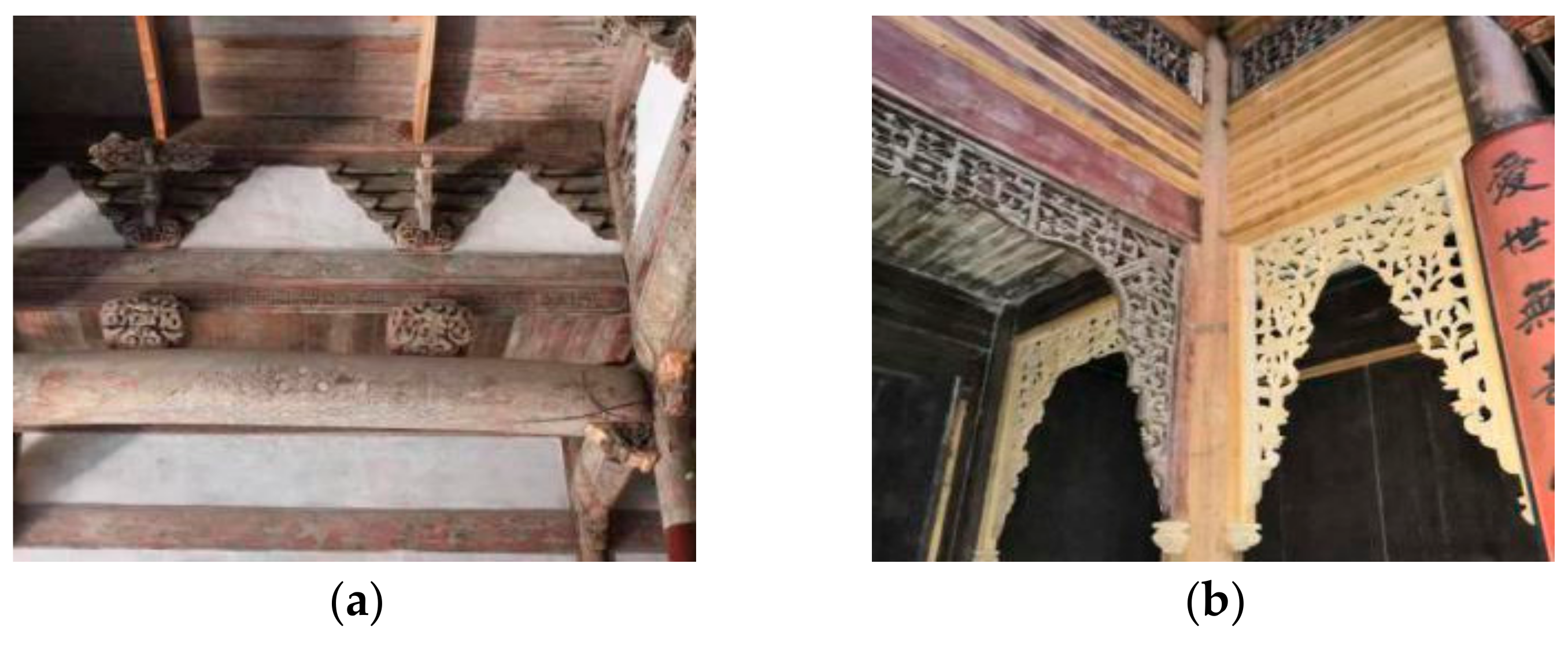
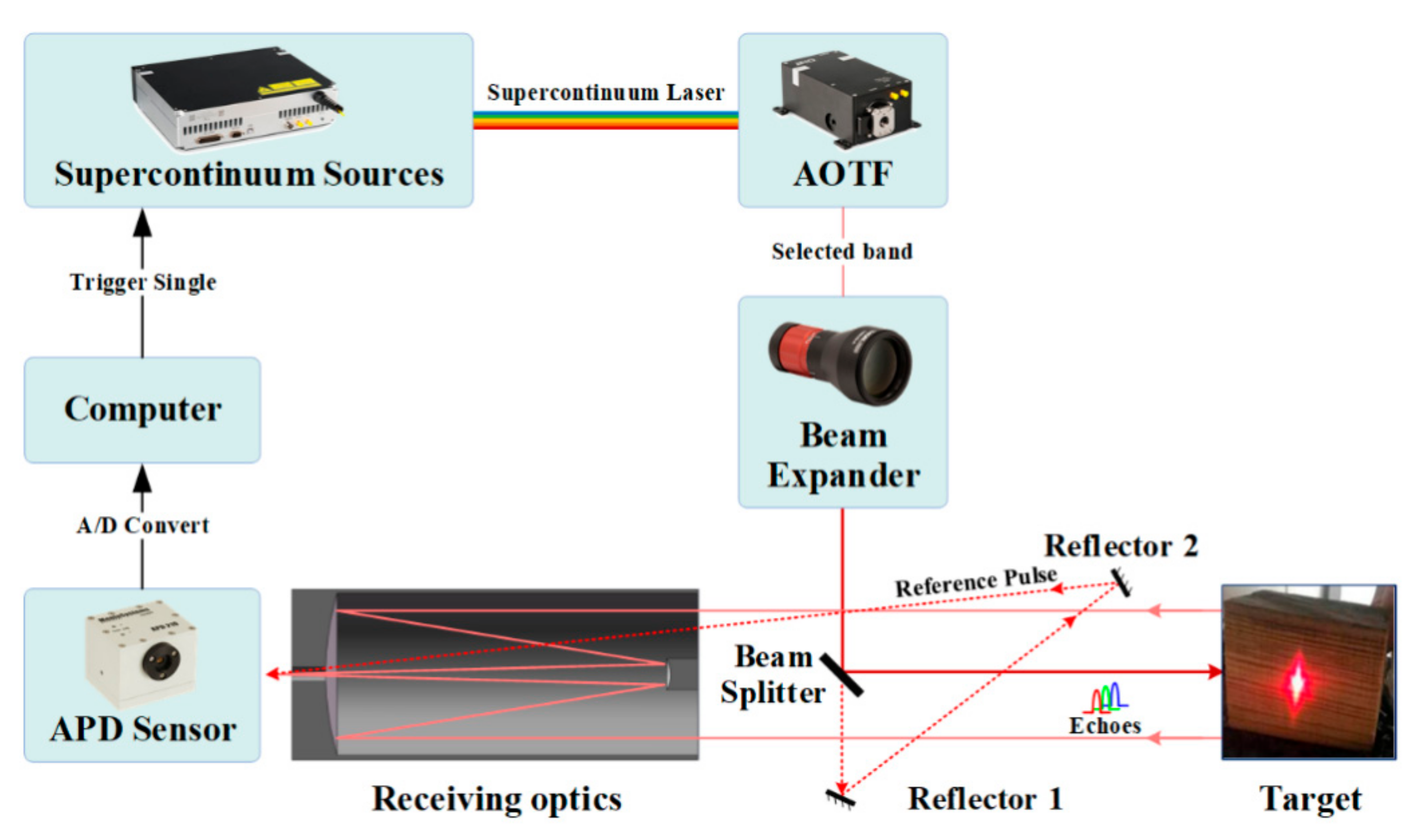
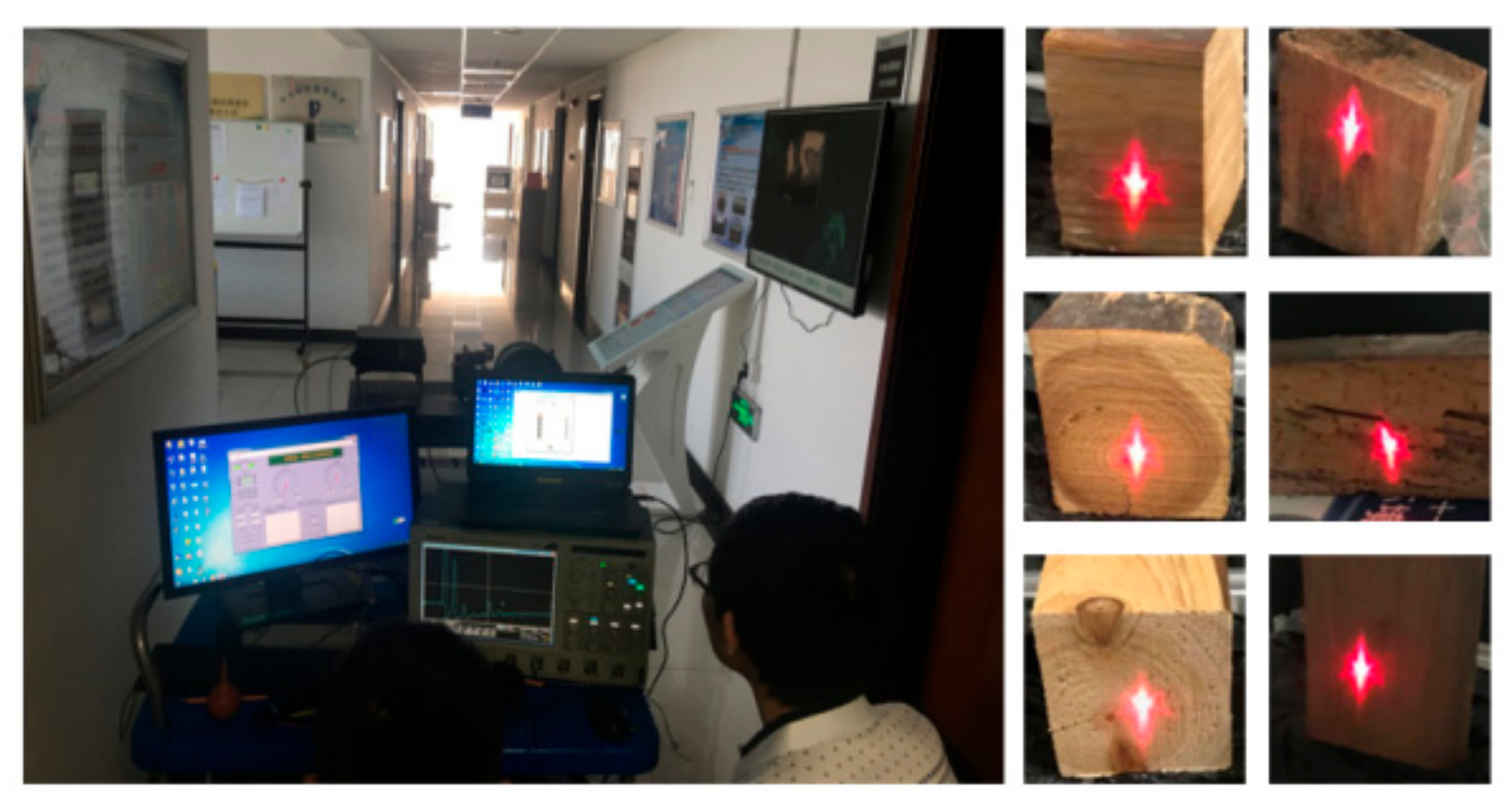
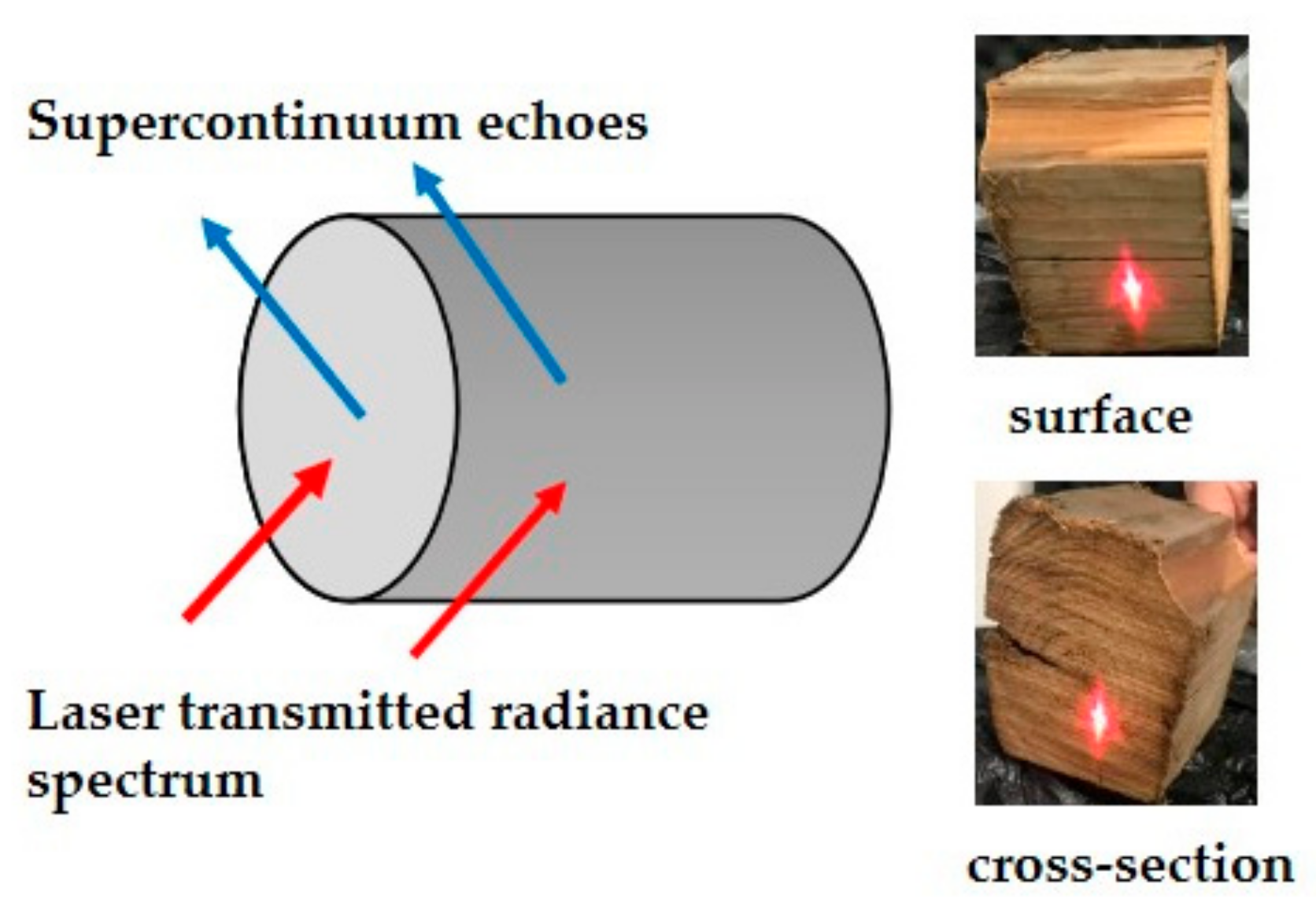
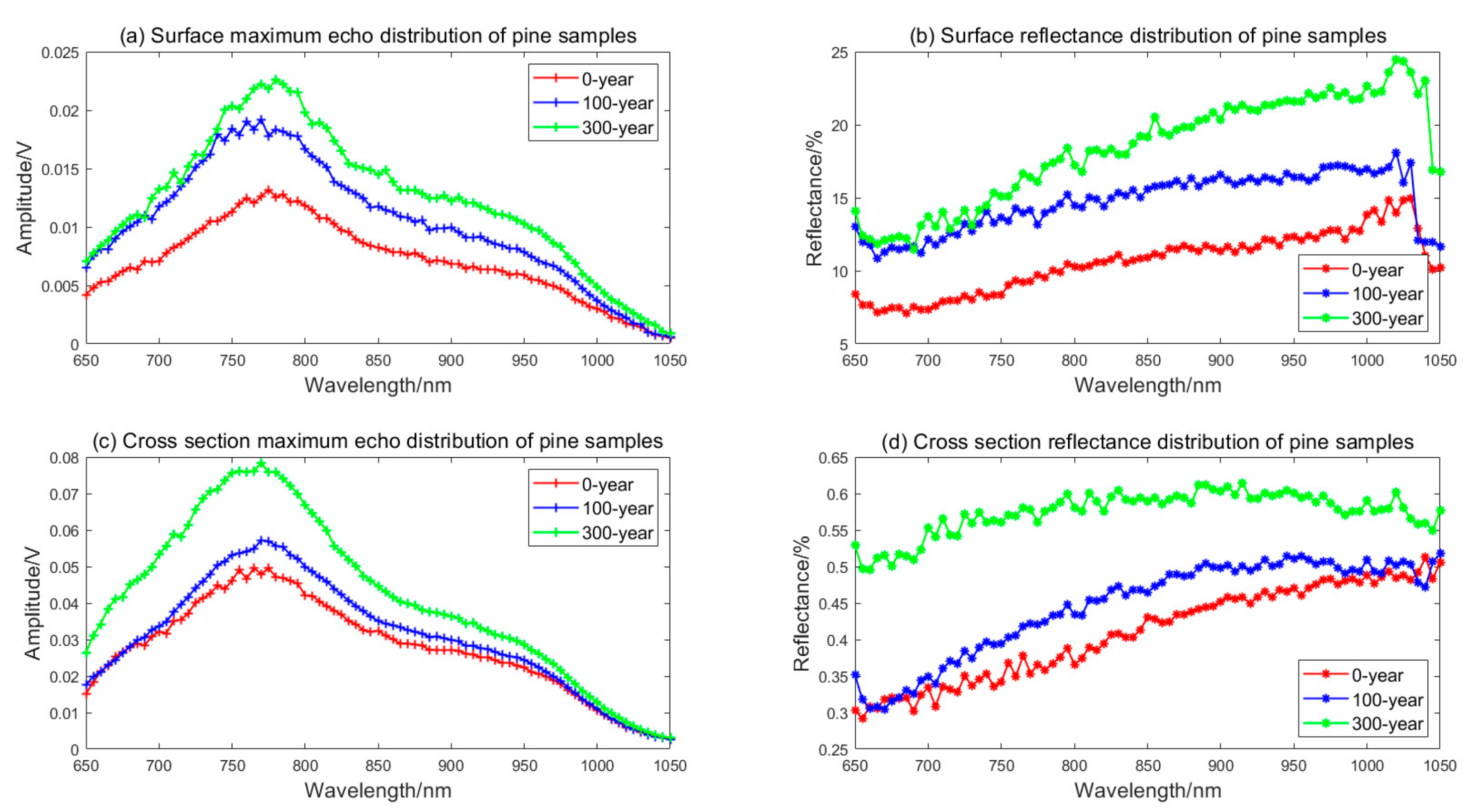
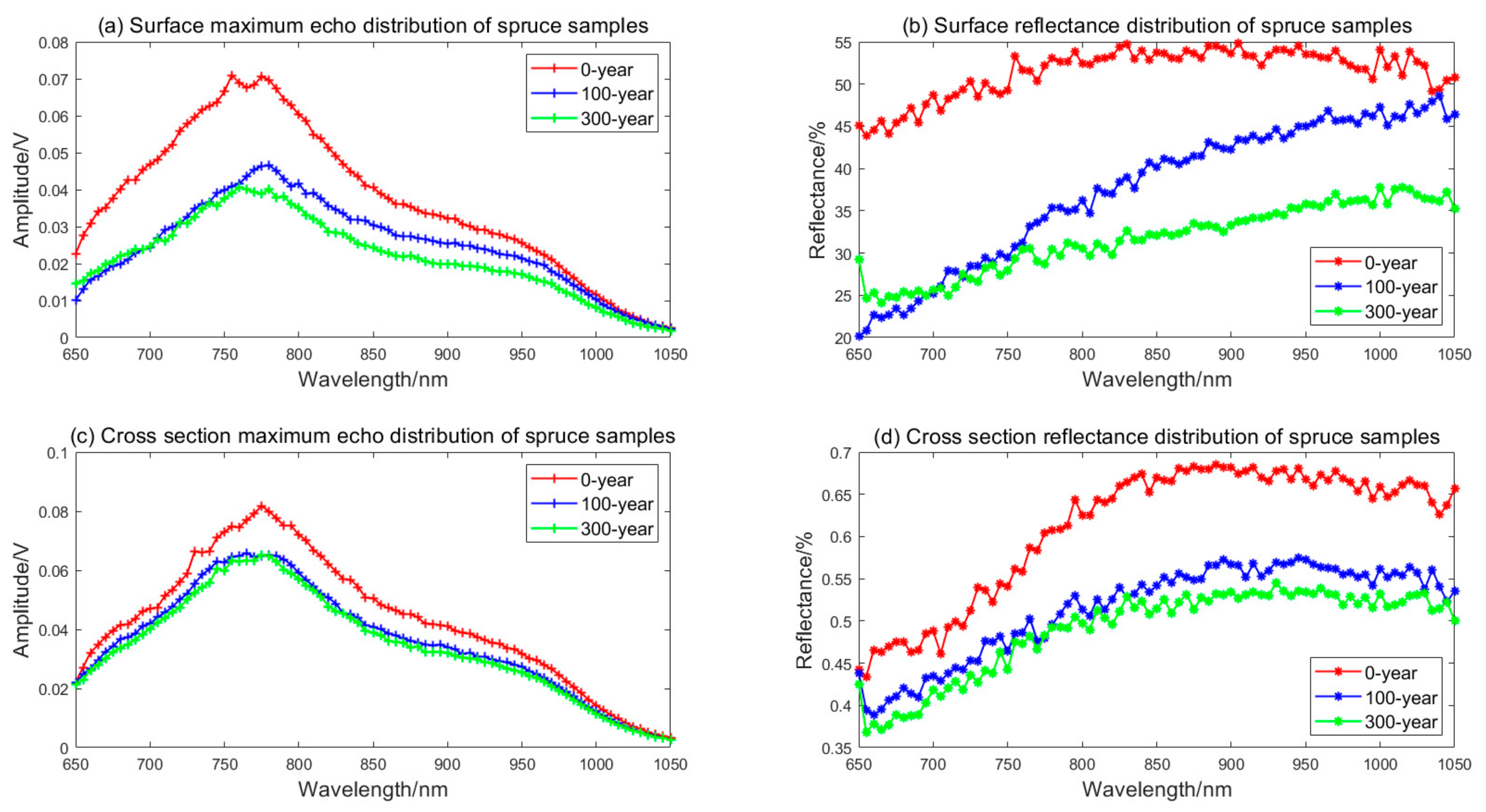
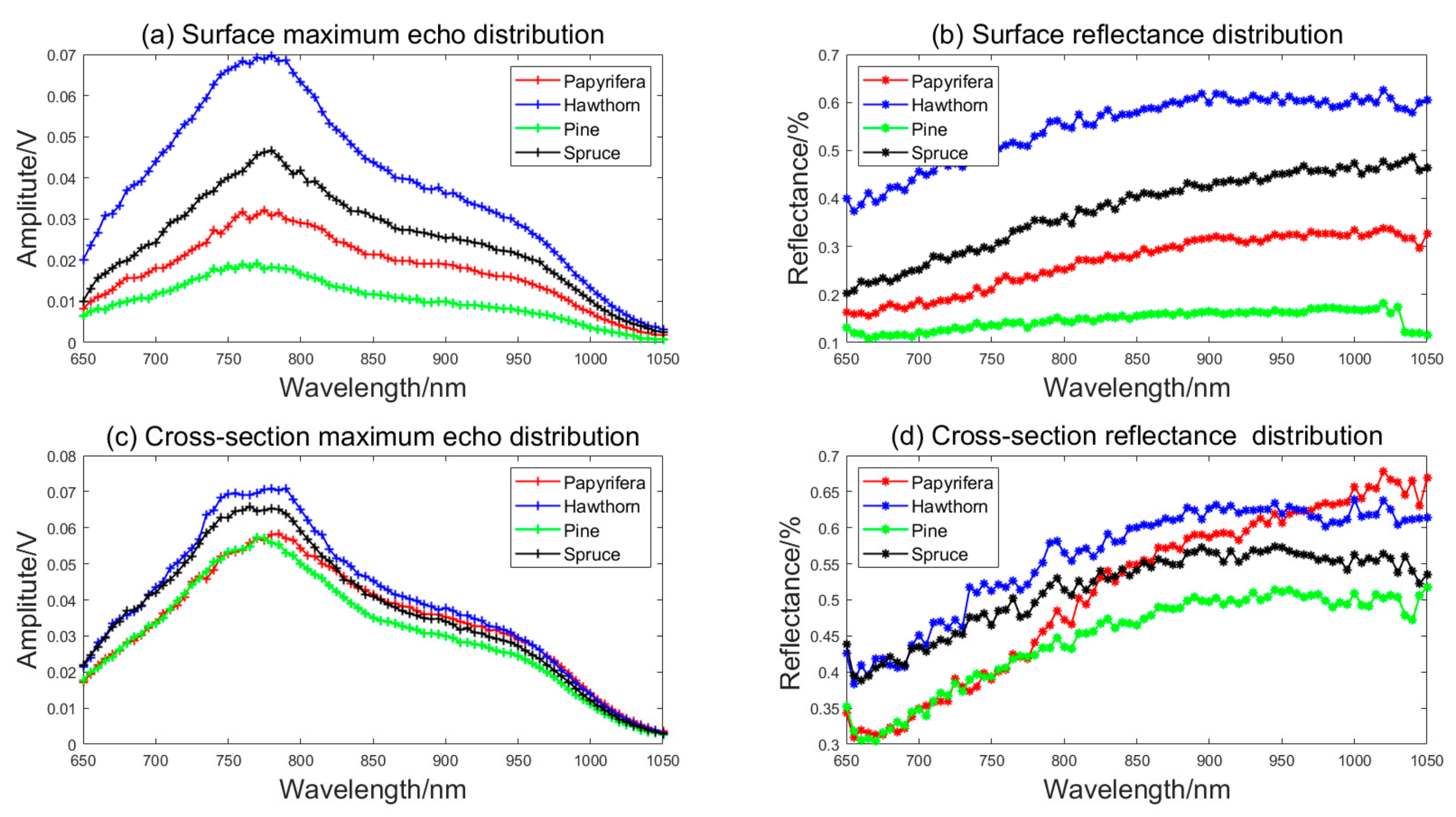
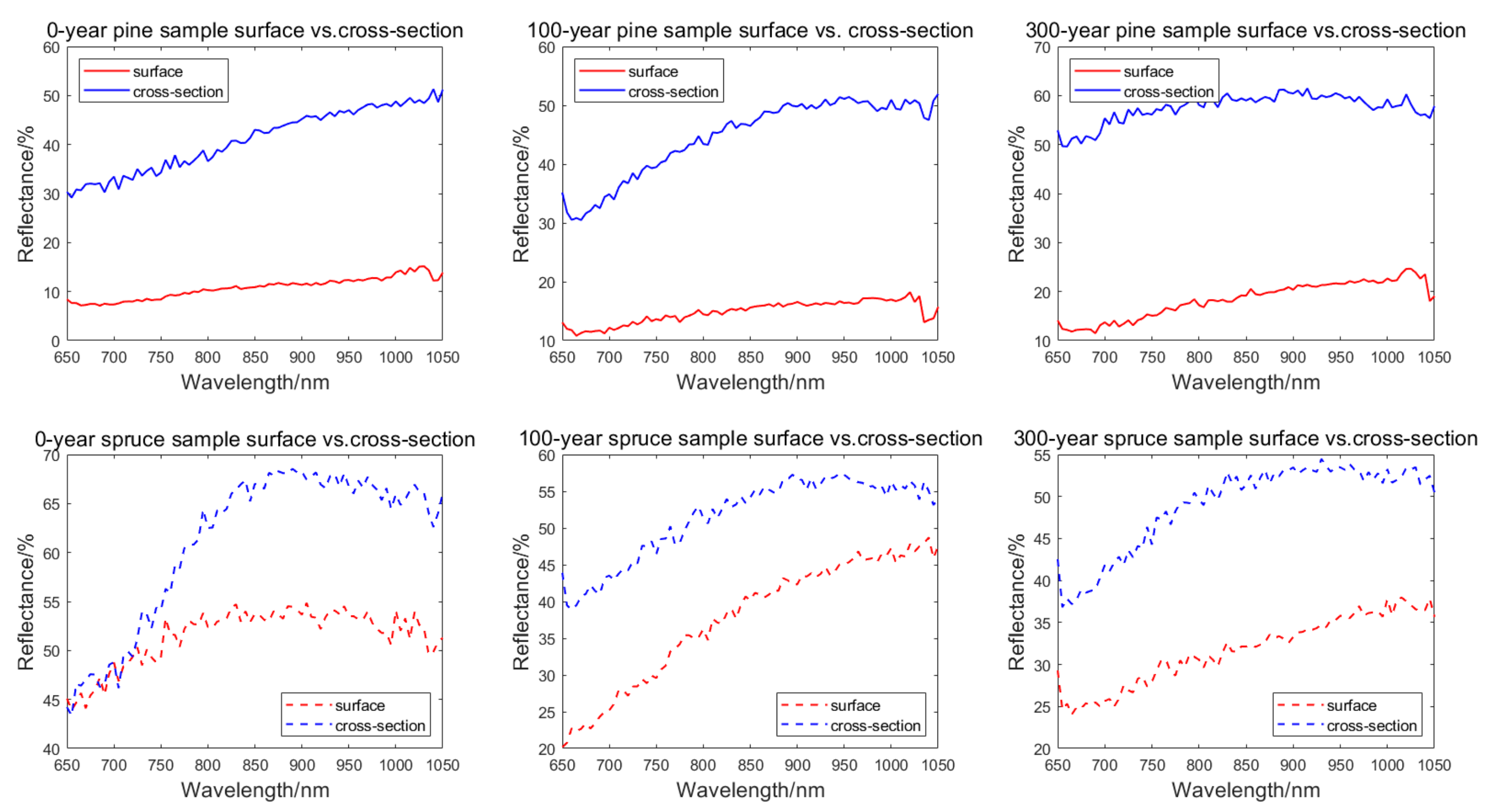
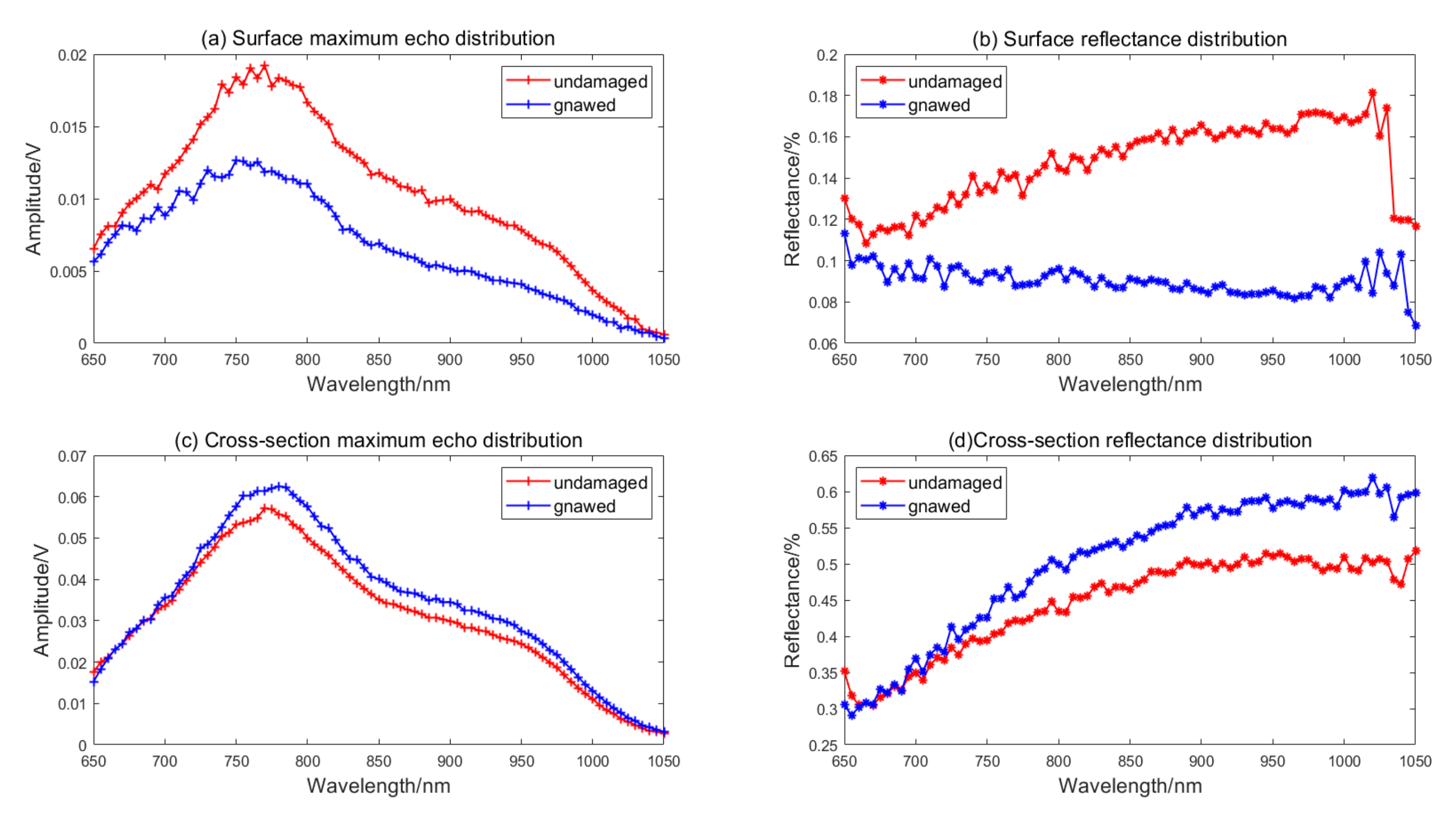
| Parameter | Description/Value |
|---|---|
| Spectral range | 650–1050 nm |
| Spectral resolution | 2–10 nm |
| Beam divergence | 0.4 mill radian |
| Beam diameter (at exit) | 10 mm |
| Species | 0-Year | 100-Year | 300-Year |
|---|---|---|---|
| Pine | √ | √ | √ |
| Spruce | √ | √ | √ |
| Hawthorn | √ | ||
| Papyrifera | √ | ||
| Gnawed pine | √ |
| Dataset | MNSC (NB) | MNSC (SVM) |
|---|---|---|
| Dataset 1 | 24 | 4 |
| Dataset 2 | 15 | 5 |
| Dataset 3 | 25 | 5 |
| Dataset 4 | 28 | 8 |
| Dataset 5 | 27 | 7 |
| Dataset 6 | 29 | 9 |
| Dataset | NB Classification Accuracy (%) Based on Number of Channels | ||||||
|---|---|---|---|---|---|---|---|
| 2 | 3 | 4 | 5 | 6 | 7 | Mean | |
| Dataset 1 | 59.81 | 63.32 | 75.05 | 75.1 | 79.09 | 81.07 | 72.24 |
| Dataset 2 | 66.76 | 83.31 | 95 | 96.32 | 96.67 | 96.66 | 89.12 |
| Dataset 3 | 58.24 | 65.06 | 71.66 | 80.04 | 80.16 | 81.34 | 72.75 |
| Dataset 4 | 61.77 | 71.63 | 76.71 | 81.64 | 90.09 | 88.23 | 78.35 |
| Dataset 5 | 58.27 | 71.67 | 74.97 | 85.01 | 86.67 | 88.38 | 77.5 |
| Dataset 6 | 45.03 | 56.72 | 73.31 | 76.65 | 79.97 | 81.63 | 68.89 |
| Mean | 58.29 | 68.62 | 77.78 | 82.46 | 85.44 | 86.22 | |
| Dataset | SVM Classification Accuracy (%) Based on Number of Channels | ||||||
|---|---|---|---|---|---|---|---|
| 2 | 3 | 4 | 5 | 6 | 7 | Mean | |
| Dataset 1 | 71.78 | 90.05 | 100 | 100 | 100 | 100 | 93.64 |
| Dataset 2 | 88.31 | 93.32 | 91.7 | 100 | 100 | 100 | 95.56 |
| Dataset 3 | 85.03 | 93.26 | 95.06 | 100 | 100 | 100 | 95.56 |
| Dataset 4 | 71.61 | 83.35 | 88.20 | 91.66 | 93.3 | 94.98 | 87.13 |
| Dataset 5 | 73.41 | 84.98 | 91.66 | 91.54 | 93.21 | 100 | 89.13 |
| Dataset 6 | 73.34 | 84.87 | 86.69 | 86.72 | 95.02 | 96.64 | 87.21 |
| Mean | 77.25 | 88.31 | 92.22 | 94.99 | 96.92 | 98.6 | |
© 2019 by the authors. Licensee MDPI, Basel, Switzerland. This article is an open access article distributed under the terms and conditions of the Creative Commons Attribution (CC BY) license (http://creativecommons.org/licenses/by/4.0/).
Share and Cite
Shao, H.; Chen, Y.; Yang, Z.; Jiang, C.; Li, W.; Wu, H.; Wang, S.; Yang, F.; Chen, J.; Puttonen, E.; et al. Feasibility Study on Hyperspectral LiDAR for Ancient Huizhou-Style Architecture Preservation. Remote Sens. 2020, 12, 88. https://doi.org/10.3390/rs12010088
Shao H, Chen Y, Yang Z, Jiang C, Li W, Wu H, Wang S, Yang F, Chen J, Puttonen E, et al. Feasibility Study on Hyperspectral LiDAR for Ancient Huizhou-Style Architecture Preservation. Remote Sensing. 2020; 12(1):88. https://doi.org/10.3390/rs12010088
Chicago/Turabian StyleShao, Hui, Yuwei Chen, Zhirong Yang, Changhui Jiang, Wei Li, Haohao Wu, Shaowei Wang, Fan Yang, Jie Chen, Eetu Puttonen, and et al. 2020. "Feasibility Study on Hyperspectral LiDAR for Ancient Huizhou-Style Architecture Preservation" Remote Sensing 12, no. 1: 88. https://doi.org/10.3390/rs12010088
APA StyleShao, H., Chen, Y., Yang, Z., Jiang, C., Li, W., Wu, H., Wang, S., Yang, F., Chen, J., Puttonen, E., & Hyyppä, J. (2020). Feasibility Study on Hyperspectral LiDAR for Ancient Huizhou-Style Architecture Preservation. Remote Sensing, 12(1), 88. https://doi.org/10.3390/rs12010088








